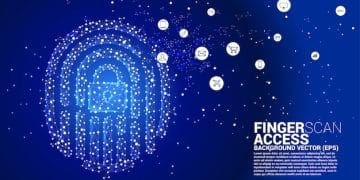Quantum Threats: Are Encryption Standards in the US at Risk?

The emergence of quantum computing presents a potential long-term challenge to current encryption standards, particularly for sensitive financial data in the US, necessitating proactive development of quantum-resistant cryptography by financial institutions and government bodies.
In the evolving digital landscape, the security of our most sensitive data hinges on the robustness of encryption. A question increasingly gaining traction is whether quantum computing breakthroughs are posing an imminent threat to current encryption standards in the US, particularly concerning personal finance. This discussion is not purely academic; its implications could profoundly reshape how we perceive digital security and manage our financial well-being.
Understanding the Quantum Leap: What is Quantum Computing?
Quantum computing represents a paradigm shift in processing power, moving beyond the classical bits of 0s and 1s to quantum bits, or qubits, which can exist in multiple states simultaneously through superposition and entanglement. This fundamental difference unlocks the potential for exponentially faster computation, capable of solving problems that are intractable for even the most powerful supercomputers today. For personal finance, understanding this leap is crucial as it underpins the very nature of the encryption challenges we face.
Unlike traditional computers that process instructions sequentially, quantum computers leverage the bizarre principles of quantum mechanics. Particles can be in multiple places at once (superposition), and their fates can be linked even when separated by vast distances (entanglement). These properties allow quantum computers to perform many calculations in parallel, leading to breakthroughs in fields like drug discovery, materials science, and, critically, cryptography.
The Core Principles of Quantum Mechanics
At the heart of quantum computing are complex principles that defy our everyday intuition. These include:
- Superposition: A qubit can represent a 0, a 1, or any combination of both simultaneously, dramatically increasing processing capacity.
- Entanglement: The state of one qubit can instantaneously influence the state of another, even if they are physically separated, enabling highly correlated operations.
- Interference: Quantum computers manipulate the probabilities of outcomes, amplifying correct answers and diminishing incorrect ones, guiding calculations towards efficient solutions.
These principles allow quantum algorithms to explore vast solution spaces much more efficiently than classical algorithms. This raw computational power is what makes quantum computing both a promise for scientific advancement and a potential vulnerability for existing cryptographic systems.
While still in its nascent stages, quantum technology is advancing rapidly. Major tech companies and governments worldwide are investing heavily, recognizing its transformative potential. Early prototypes are demonstrating the feasibility of quantum computations, albeit on limited scales. The key takeaway for anyone concerned about personal finance security is that quantum capabilities are not a distant dream but an active area of development, requiring foresight and preparedness rather than immediate panic.
The progression of quantum computing hinges on overcoming significant engineering challenges, such as maintaining the delicate quantum states of qubits for extended periods and scaling up the number of stable qubits. However, the theoretical underpinnings are sound, and the practical demonstrations are growing more sophisticated. This foundational understanding sets the stage for comprehending how these breakthroughs could specifically impact the digital fortresses that protect our financial data, particularly within the US’s digital infrastructure.
Current Encryption Standards: The Backbone of Digital Security
Our digital world, including every online financial transaction, relies heavily on robust encryption standards. These standards, predominantly based on public-key cryptography, asymmetric and symmetric encryption, are the silent guardians of our data, ensuring privacy, integrity, and authenticity. For individuals managing their personal finances, understanding these foundational standards is crucial to appreciating the potential impact of quantum developments. Public-key encryption, specifically, forms the bedrock of secure online communication, from banking portals to e-commerce, ensuring that only the intended recipient can decipher sensitive information.
The vast majority of today’s digital security, including secure sockets layer (SSL) and transport layer security (TLS) protocols that protect websites, relies on the computational difficulty of certain mathematical problems. For instance, the security of RSA (Rivest–Shamir–Adleman) encryption depends on the challenge of factoring large numbers into their prime components. Similarly, elliptic curve cryptography (ECC) relies on the complexity of discrete logarithm problems on elliptic curves. These problems are computationally unfeasible for classical computers to solve within a practical timeframe, making the encryption effectively unbreakable today.
Key Encryption Standards in Use
Several types of encryption are ubiquitous in safeguarding our digital lives:
- Asymmetric (Public-Key) Encryption: Uses a pair of keys—a public key for encryption and a private key for decryption. Examples include RSA and ECC, critical for secure online transactions and digital signatures.
- Symmetric Encryption: Uses a single secret key for both encryption and decryption. Advanced Encryption Standard (AES) is a prominent example, used for bulk data encryption once a secure connection is established.
- Hash Functions: One-way functions that create fixed-size strings of characters from input data, used for verifying data integrity and storing passwords securely (e.g., SHA-256).
The strength of these algorithms lies in the sheer computational effort required to break them. A brute-force attack on a strong AES-256 key, for example, would literally take billions of years with today’s supercomputers. This forms the basis of trust we place in our online financial systems, knowing that our passwords, bank details, and investment portfolios are safeguarded by mathematical complexity.
However, the theoretical vulnerability lies in the specific mathematical problems these algorithms rely upon. While classical computers struggle with factoring large numbers or solving discrete logarithms, quantum computers, with algorithms like Shor’s and Grover’s, are theoretically capable of tackling these problems with unprecedented efficiency. This is where the “threat” aspect of quantum computing enters the discussion regarding our existing cybersecurity infrastructure.
It’s important to differentiate between theoretical capabilities and practical implementation. While Shor’s algorithm provides a theoretical pathway to break RSA and ECC, building a fault-tolerant quantum computer large enough to execute Shor’s algorithm on cryptographically relevant key sizes is a monumental engineering challenge that has yet to be achieved. Nonetheless, the very possibility necessitates proactive measures and a shift in cryptographic thinking, especially within the financial sector where the stakes of a security breach are astronomically high. The current standards are robust for classical threats, but they are not inherently designed to withstand quantum attacks, making the exploration of quantum-resistant alternatives a critical national security and personal finance concern.

The Quantum Threat Landscape: Shor’s and Grover’s Algorithms
The core of the theoretical threat quantum computing poses to current encryption standards stems from two specific quantum algorithms: Shor’s algorithm and Grover’s algorithm. These algorithms, independently developed, offer pathways to significantly reduce the computational time required to break the mathematical problems that underpin much of our modern encryption. Understanding their mechanisms is key to grasping why quantum breakthroughs are viewed with such caution by cybersecurity experts, especially in the context of sensitive financial data in the US.
Shor’s algorithm, proposed by Peter Shor in 1994, is perhaps the most famous and concerning. It offers an exponential speedup over classical algorithms for factoring large numbers and solving the discrete logarithm problem. These are precisely the problems upon which RSA and ECC, the two most widely used public-key cryptographic systems, rely for their security. If a sufficiently large and stable quantum computer were to become available, Shor’s algorithm could theoretically render these foundational encryption methods obsolete, exposing vast amounts of previously encrypted data.
Impact of Key Quantum Algorithms
- Shor’s Algorithm: Directly threatens asymmetric encryption (RSA, ECC) by efficiently solving integer factorization and discrete logarithm problems. This could compromise secure communication, digital signatures, and key exchange protocols.
- Grover’s Algorithm: Offers a quadratic speedup for searching unsorted databases. While it doesn’t break symmetric encryption (like AES) directly, it reduces the effective key length. An AES-256 encryption would effectively become AES-128 under a Grover’s attack, still strong but requiring longer key lengths for equivalent security. It also impacts hash functions, making brute-force attacks more feasible.
The implication of Shor’s algorithm is particularly dire for public-key cryptography. Without robust public-key encryption, the initial secure handshake for nearly all online transactions, including credit card payments, online banking logins, and secure email, would be compromised. The entire trust model of the internet, where we assume our communications are private and authentic, could unravel.
Grover’s algorithm, while less of an existential threat than Shor’s, still requires consideration. Its ability to speed up brute-force searches means that larger key sizes would be needed for symmetric encryption to maintain the same level of security against a quantum adversary. For instance, if a 128-bit key is currently considered secure, a quantum-resistant future might demand a 256-bit symmetric key to offer comparable protection.
It’s critical to note that while the theoretical threat is clear, the “imminent” aspect is subject to ongoing debate. Current quantum computers are not powerful enough to run Shor’s algorithm on key sizes relevant to real-world encryption. They are noisy, error-prone, and have a limited number of qubits. However, the trajectory of quantum computing research suggests that building increasingly capable machines is a matter of “when,” not “if.” This uncertainty highlights the national security imperative for the US government and financial institutions to invest in quantum-resistant cryptography research and development, rather than waiting until the threat materializes into a present danger.
“Imminent” vs. “Potential”: Assessing the Timeline for Personal Finance
When discussing the quantum threat to encryption, the distinction between “imminent” and “potential” is paramount, especially for individuals concerned about their personal finances. While quantum computing breakthroughs are indeed happening, the timeline for these breakthroughs to pose an actual, practical threat to widely used encryption in the US is a subject of intense debate among experts. It’s not a question of immediate panic, but rather one of proactive readiness and understanding the varying estimates of when “Crypto-Apocalypse” might arrive.
Most cybersecurity experts agree that a “cryptographically relevant” quantum computer—one powerful enough to break current public-key encryption standards like RSA and ECC in a practical timeframe—is still years, if not a decade or more, away. This timeline is often referred to as “Y2Q” (Years to Quantum), and predictions vary widely, largely due to advancements in quantum error correction and qubit stability. The significant challenges of building such a machine, specifically in achieving a fault-tolerant system with a sufficient number of stable qubits, mean the threat is currently potential, rather than imminent.
Factors Influencing the Threat Timeline
- Qubit Stability and Error Rates: Current quantum computers are prone to errors. Significant advancements in error correction techniques are needed to run complex algorithms like Shor’s reliability.
- Number of Qubits: The number of stable, interconnected qubits required to break commonly used encryption (e.g., 2048-bit RSA) is estimated to be in the millions, far exceeding today’s hundreds of noisy qubits.
- Algorithm Development and Optimization: While Shor’s algorithm exists, its practical implementation on large-scale encryption would require significant optimization and new approaches to handle large datasets.
For individuals managing their personal finances, this means there’s no immediate need to abandon online banking or fear that their current encrypted communications are instantly vulnerable. However, the “potential” nature of the threat should not be dismissed entirely. The data captured today, commonly known as “harvest now, decrypt later,” is a significant concern. Malicious actors could be collecting encrypted data now, anticipating that they will be able to decrypt it once quantum computers become powerful enough. This risk underscores the urgency for certain high-security sectors, like government and finance, to begin transitioning to quantum-resistant solutions.
The US government, through agencies like the National Institute of Standards and Technology (NIST), has already initiated a post-quantum cryptography (PQC) standardization process. This proactive approach acknowledges the potential threat and aims to establish new, quantum-resistant algorithms before they are critically needed. Financial institutions, too, are starting to explore and implement quantum-safe protocols for their long-term security strategies, recognizing that the transition will be complex and time-consuming.
Ultimately, while quantum computing is making rapid strides, its ability to break current encryption standards for personal finance security is not an imminent, day-to-day threat. Instead, it is a significant potential challenge that demands strategic planning, research, and gradual implementation of new cryptographic standards. The “imminent” urgency is felt more by those developing and deploying these advanced cryptographic solutions than by the average consumer, whose daily transactions remain secure under current standards for the foreseeable future. This gives us crucial time to transition effectively, but delays could prove costly down the line.
The US Response: A Proactive Stance on Post-Quantum Cryptography
Recognizing the long-term strategic implications of quantum computing, the US has taken a decidedly proactive stance in preparing for a post-quantum cryptographic (PQC) era. This foresight is crucial, particularly for protecting classified information, critical infrastructure, and the vast financial data streams that underpin the nation’s economy. The US government, primarily through NIST, has been at the forefront of this global effort, aiming to standardize new encryption algorithms that can withstand attacks from future quantum computers, ensuring the continued security of digital communications and financial systems.
NIST initiated a multi-year standardization process for PQC algorithms in 2016, inviting cryptographic experts worldwide to submit, evaluate, and eventually select new algorithms. This rigorous process mimics the successful standardization of AES, ensuring that the chosen quantum-resistant algorithms are robust, efficient, and widely implementable. The selected algorithms are designed to be resistant to known quantum attacks, such as those leveraging Shor’s and Grover’s algorithms, while still being executable on classical computers.
Key Initiatives and Milestones
- NIST Post-Quantum Cryptography Standardization: A multi-round competition to identify and standardize quantum-resistant algorithms for public-key encryption and digital signatures.
- Government Directives: Executive orders and national security memorandums instructing federal agencies to prepare for the quantum transition, including inventorying cryptographic systems and developing migration plans.
- Research Funding and Collaboration: Significant investment in quantum computing research and PQC development across government, academia, and industry to accelerate solutions.
The standardization process has progressed significantly, with finalists and alternate candidates across various categories (e.g., lattice-based, code-based, hash-based cryptography) being rigorously vetted. The initial set of standardized algorithms, expected in 2024, will provide a crucial foundation for organizations to begin transitioning their systems. This transition, often referred to as “crypto-agnostic” or “crypto-agility,” involves building systems that can easily swap out cryptographic algorithms as new standards emerge or as existing ones become vulnerable.
Beyond NIST, various US government agencies, including the National Security Agency (NSA) and the Cybersecurity and Infrastructure Security Agency (CISA), are actively involved in guiding the transition. Their guidance emphasizes the need for a comprehensive approach, including identifying cryptographic assets, prioritizing migration based on data sensitivity and lifespan, and implementing hybrid solutions that combine current and quantum-resistant algorithms during the transition phase. This staggered approach aims to maintain security during the complex migration period, ensuring continuity of operations, particularly within the financial sector.
While the US response is aggressive and forward-looking, the sheer scale of the cryptographic update across the nation’s digital infrastructure presents a monumental challenge. It requires collaboration between government, industry, and academia, significant investment in research and development, and meticulous planning to avoid disruptions. However, this proactive stance is a strong indicator that the US is not only aware of the potential quantum threat to current encryption standards but is also taking concrete, measured steps to mitigate it, safeguarding future digital security for personal finance and beyond.

Impact on Personal Finance: What Consumers Should Know
While the broader discussion about quantum computing and encryption often revolves around nation-state security and corporate data, the implications for an individual’s personal finance are directly relevant. Understanding these potential impacts, even if the threat isn’t imminent, can help consumers appreciate the importance of ongoing cybersecurity efforts and how their financial data is being protected in the long term by financial institutions and government entities in the US.
Firstly, it’s crucial to reiterate that your online banking, credit card transactions, and investment accounts are currently secure. The encryption standards in place are robust against all known classical attacks, and quantum computers are not yet powerful enough to break them. There is no immediate need for individuals to change their financial habits or panic about their existing digital assets. However, the “harvest now, decrypt later” scenario is a theoretical concern for long-lived sensitive data, like Social Security numbers or health records, if they are intercepted and stored today with the intent of quantum decryption in the future. For most ephemeral financial transactions, this risk is less pronounced due to their relatively short shelf life, but privacy is still paramount.
Key Considerations for Personal Finance
- No Immediate Action Required: Your current online financial activities are secure. Financial institutions are aware of the quantum threat and are actively planning for the transition.
- Data Lifespan Matters: Data with a long confidentiality requirement (e.g., social security numbers, medical records, long-term investment strategies) could be at higher risk for “harvest now, decrypt later” scenarios, though active interception without immediate decryption is challenging.
- Trust in Financial Institutions and Government: The security of your personal finance ultimately hinges on the ability of banks, financial service providers, and government agencies to implement quantum-resistant solutions.
Banks and financial institutions in the US are highly regulated and possess sophisticated cybersecurity teams. They are actively monitoring the PQC standardization process and are beginning to integrate quantum-safe principles into their long-term technology roadmaps. This includes exploring pilot programs for quantum-resistant algorithms, assessing their cryptographic inventory, and developing strategies for a smooth transition. Their primary goal is to ensure business continuity and customer trust by safeguarding financial transactions and sensitive data, regardless of future technological advancements.
Consumers can play a role by maintaining good cyber hygiene practices today, which will remain relevant in a post-quantum world. This includes using strong, unique passwords, enabling multi-factor authentication (MFA) wherever possible, being wary of phishing attempts, and keeping software updated. These practices create fundamental layers of security that complement cryptographic protections and are effective regardless of the underlying encryption algorithms.
Ultimately, the impact of quantum computing on personal finance is a long-term strategic challenge for the institutions that protect our money, rather than an immediate risk for individual consumers to manage directly. The proactive measures being taken by the US government and the financial sector aim to ensure that by the time cryptographically relevant quantum computers become a reality, the necessary transitions to quantum-resistant encryption will have been made. This forward-thinking approach is designed to maintain the integrity and security of the US financial system, thereby safeguarding the personal finances of its citizens against future quantum threats.
Future-Proofing Financial Security: The Path Ahead
The path to future-proofing financial security in the face of quantum computing breakthroughs involves a monumental, collaborative effort across government, industry, and academia. It’s a proactive journey of cryptographic migration, standardization, and education, ensuring that the digital fortresses protecting our personal finances against current encryption standards in the US remain robust for decades to come. This transition is not a simple patch; it’s a fundamental overhaul of the cryptographic backbone of our digital world, requiring careful planning and execution.
The cornerstone of this path is the global standardization of quantum-resistant algorithms, primarily led by NIST in the US. Once these algorithms are finalized, the next monumental step is their widespread adoption and implementation. This “rip and replace” of cryptographic primitives will be a complex, multi-year endeavor, impacting countless systems, applications, and devices that rely on cryptography. Financial institutions, given the high value and sensitivity of the data they handle, are expected to be among the early adopters and leaders in this transition, integrating PQC into their security architectures.
Key Steps in Future-Proofing Financial Security
- Algorithm Standardization: Finalizing and publishing the new suite of quantum-resistant cryptographic algorithms by NIST and other international bodies.
- Education and Awareness: Informing developers, IT professionals, and the public about the quantum threat and the need for PQC migration.
- System Inventory and Prioritization: Identifying all cryptographic assets within an organization, assessing their exposure, and prioritizing migration based on risk and data lifespan.
- Hybrid Mode Implementation: During the transition, commonly using “hybrid” cryptographic modes that combine both classical and post-quantum algorithms to maintain security against both classical and potential quantum adversaries simultaneously.
- Quantum-Safe Hardware and Software: Developing and deploying new hardware modules and software libraries that natively support the new PQC algorithms.
Another critical aspect of future-proofing is building “crypto-agility” into systems. This means designing security architectures in such a way that cryptographic algorithms can be easily updated or swapped out without requiring a complete system redesign. Such agility will be vital not only for the current quantum transition but also for adapting to future cryptographic breakthroughs or vulnerabilities that may emerge. Financial service providers are increasingly investing in and deploying agile cryptographic frameworks to streamline future updates.
Furthermore, ongoing research and development in quantum computing and cryptography are essential. The field of quantum computing is evolving rapidly, and continuous vigilance is required to ensure that the chosen PQC algorithms remain secure against increasingly powerful quantum machines. Researchers are exploring novel cryptographic approaches and mathematical problems that are believed to be hard even for quantum computers, forming layers of defense against unforeseen future attacks.
The journey to future-proof financial security against quantum threats is a marathon, not a sprint. It necessitates sustained investment, global cooperation, and an unwavering commitment to cybersecurity innovation. For individuals, this means continued trust in the systems and institutions that protect their finances, knowing that experts are diligently working to build a more secure digital future against all potential computational advancements. This proactive approach ensures that the vast benefits of quantum computing can be harnessed without compromising the fundamental pillar of digital trust.
Recommendations for Protecting Your Financial Data Now and Beyond
While the direct quantum threat to your personal finance is not imminent, taking proactive steps today can significantly bolster your overall digital security and prepare you for any future shifts in the cryptographic landscape. Protecting your financial data is an ongoing process that goes beyond just encryption; it involves diligent practices and an informed approach to your online presence. These recommendations aim to empower individuals to safeguard their digital assets now and build resilience for the future.
The most immediate and effective measures are often the simplest. Strong, unique passwords are your first line of defense. Utilizing a reputable password manager can help you generate and securely store complex passwords for each of your online accounts, eliminating the need to remember them all and reducing the risk of credential stuffing attacks. Coupled with strong passwords, multi-factor authentication (MFA) should be enabled on all financial accounts and other critical services whenever available. MFA, whether through an authenticator app, a physical security key, or SMS codes, adds a crucial second layer of verification, making it significantly harder for unauthorized individuals to access your accounts even if they somehow obtain your password.
Best Practices for Personal Financial Security
- Use Strong, Unique Passwords: Leverage a password manager to create and secure complex passwords for all accounts.
- Enable Multi-Factor Authentication (MFA): Activate MFA on all financial accounts and email. It is a critical layer of defense.
- Beware of Phishing and Social Engineering: Be skeptical of unsolicited emails, texts, or calls requesting personal or financial information. Verify the sender’s legitimacy before clicking links or providing data.
- Regularly Update Software: Keep your operating system, web browsers, and financial apps updated. Software updates often include critical security patches against newly discovered vulnerabilities.
- Monitor Financial Accounts: Regularly review bank statements, credit card transactions, and credit reports for any suspicious activity. Promptly report any discrepancies to your financial institution.
Beyond these foundational practices, staying informed about cybersecurity trends, though not necessarily delving into the intricate details of quantum physics, can be beneficial. Reputable news sources and cybersecurity blogs often provide updates relevant to consumers. Understanding the general principles of data privacy and the evolving threat landscape equips you to make more informed decisions about your digital footprint. For instance, being aware of data breaches at companies you do business with allows you to take immediate protective measures, such as changing passwords for affected accounts.
Remember that financial institutions are heavily invested in securing your data. They employ advanced encryption technologies, fraud detection systems, and robust incident response plans. Their transition to quantum-resistant cryptography will be a significant undertaking, but it is one they are actively preparing for. Your trust in their ongoing efforts, combined with your personal diligence in practicing good cyber hygiene, forms a powerful defense against both current and future digital threats, ensuring the continued security of your personal finance in the US and globally.
| Key Point | Brief Description |
|---|---|
| ⚛️ Quantum Threat | Shor’s and Grover’s algorithms could break current encryption (RSA, ECC) with sufficiently powerful quantum computers. |
| ⏱️ Timeline | “Crypto-relevant” quantum computers are 10+ years away; threat is potential, not imminent. |
| 🇺🇸 US Response | NIST is standardizing post-quantum cryptography (PQC) to prepare for future quantum attacks. |
| 💸 Personal Finance | Current financial data remains secure; institutions are proactively planning for quantum-safe transitions. |
Frequently Asked Questions About Quantum Encryption Threats
▼
A quantum computer uses quantum-mechanical phenomena like superposition and entanglement to process information. Unlike classical computers with bits as 0s or 1s, quantum computers use qubits, which can simultaneously be 0, 1, or both, allowing them to solve complex problems much faster.
▼
Yes, your online banking is currently safe. Existing encryption standards are robust against all known classical attacks, and today’s quantum computers are not yet powerful enough to break them. Financial institutions are actively preparing for future quantum-safe transitions.
▼
Shor’s algorithm can efficiently factor large numbers and solve discrete logarithms, threatening public-key encryption like RSA and ECC. Grover’s algorithm speeds up database searches, potentially reducing the effective key length of symmetric encryption like AES. Both challenge current cryptographic security.
▼
Post-quantum cryptography refers to new cryptographic algorithms designed to be secure against attacks from future quantum computers, while still being able to run on classical computers. NIST in the US is leading the global effort to standardize these new algorithms for adoption.
▼
While larger entities handle the quantum transition, you can enhance your security by using strong, unique passwords, enabling multi-factor authentication, being vigilant against phishing, keeping software updated, and regularly monitoring your financial accounts for unusual activity.
Conclusion
In conclusion, the question of whether quantum computing breakthroughs pose an imminent threat to current encryption standards in the US, particularly for personal finance, is nuanced. While significant advancements in quantum computing are indeed occurring, the consensus among experts is that a cryptographically relevant quantum computer capable of breaking widely used encryption is still years away. The threat is, therefore, more potential than imminent. However, this foresight has spurred proactive measures within the US government and the financial sector, leading to a global effort spearheaded by NIST to develop and standardize post-quantum cryptography. The objective is to ensure a seamless transition to quantum-resistant algorithms before existing encryption can be compromised, safeguarding the integrity and privacy of our digital financial infrastructure. For the individual, the best defense remains sound cybersecurity practices coupled with trust in the institutions that are actively future-proofing our digital economy against this complex, evolving technological challenge.





